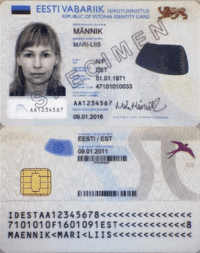Estonian ID card

The Estonian identity card (Estonian: ID-kaart) is a smart card issued in Estonia by the Police and Border Guard Board (until 2010 by the Citizenship and Migration Board) of the Ministry of Internal Affairs. It is recognised for travel by all member states of the European Union and EFTA and some other European countries as an official travel document. For most travel outside of Europe, Estonian citizens require an Estonian passport instead. All Estonian citizens and permanent residents are legally obliged to possess an Estonian identity card from the age of 15.
Stored data
The card's chip stores digitised data about the authorised user, most importantly: the user's full name, gender, national identification number, and cryptographic keys and public key certificates.
Categories of Estonian identity cards
| type | front | back |
|---|---|---|
| Estonian citizen | ||
| EU/EEA citizen | ||
| EU/EEA family permit holder | ||
| long-term residence permit holder | ||
| temporary residence permit holder |
Cryptographic use
The card's chip stores a key pair, allowing users to cryptographically sign digital documents based on principles of public key cryptography using DigiDoc. While it is possible also to encrypt documents using the card-holder's public key, this is used only infrequently, as such documents would become unreadable if the card were lost or destroyed.
By 27 May 2014, 160,809,440 electronic signatures were given, thus averaging to 10 signatures per card user per year.[1]
Under Estonian law, since 15 December 2000 the cryptographic signature is legally equivalent to a manual signature.[2]
Uses for identification
The card's compatibility with standard X.509 infrastructure has made it a convenient means of identification for use of web-based government services in Estonia (see e-Government). All major banks, many financial and other web services support ID-card based authentication.
Web discussion forums
Web commentary columns of some Estonian newspapers, most notably Eesti Päevaleht, used to support ID-card based authentication for comments. This approach caused some controversy in the internet community.[3]
Public transport
Larger cities in Estonia, such as Tallinn and Tartu, have arrangements making it possible for residents to purchase "virtual" transportation tickets linked to their ID cards.
Period tickets can be bought online via electronic bank transfer, by SMS, or at public kiosks. This process usually takes less than a few minutes and the ticket is instantly active from the moment of purchase.
Customers also have the option of requesting e-mail or SMS notification alerting them when the ticket is about to expire, or of setting up automatic renewal through internet banking services.
To use the virtual ticket, customers must carry their ID card with them whenever they use public transport. During a routine ticket check, users are asked to present their ID card, which is then inserted into a special device. This device then confirms that the user holds a valid ticket, and also warns if the ticket is about to expire. The ticket check usually takes less than a second.
Ticket information is stored in a central database, not on the ID card itself. Thus, to order a ticket, it is not necessary to have an ID-card reader. Ticket controllers have access to a local archive of the master database. If the ticket was purchased after the local archive was updated, the ticket device is able to confirm the ticket from the master database over GSM data link.
Electronic voting
The Estonian ID card is also used for authentication in Estonia's ambitious Internet-based voting programme.
In February 2007, Estonia was the first country in the world to institute electronic voting for parliamentary elections. Over 30 000 voters participated in the country's e-election.[4] In the Parliamentary election of 2011 140,846 votes were cast electronically representing 24% of total votes.[5]
The software used in this process is available for Microsoft Windows, Mac OS X and Linux.
Use as a travel document
Since Estonia's accession to the European Union (EU) in 2004, Estonian citizens who possess an Estonian identity card have been able to use it as an international travel document, in lieu of a passport, for travel within the EU countries and also to Albania, Andorra, Bosnia and Herzegovina, Iceland, Liechtenstein, Macedonia, Monaco, Montenegro, Norway, San Marino, Serbia, Switzerland and Vatican City.
However, non-Estonian citizens resident in Estonia are unable to use their Estonian identity cards as an international travel document, except that EU/EEA citizens can use cards issued since 3 September 2007 for traveling inside the Schengen area.
See also
References
- ↑ Estonian ID-card
- ↑ Elektrooniline Riigi Teataja: Digitaalallkirja seadus (this version valid from 8 January 2004 up to 31 December 2007)
- ↑ PRIIT HÕBEMÄGI: Anonüümsete kommentaaride lõpetamise kommentaarid
- ↑ idBlog - The number of electronic voters tripled
- ↑ http://www.vvk.ee/riigikogu-valimised-2011/statistika-2011/e-haaletamise-statistika/